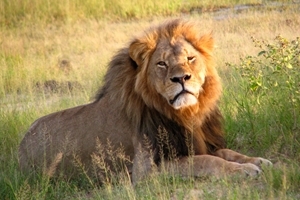A briefing paper for government
 Debate around trophy hunting has continued for some time, but earlier this year a group of Members of the European Parliament (MEPs) called for a complete ban on the import of trophies into the EU. In response, the International Union for Conservation of Nature (IUCN) published a briefing paper, which aims to inform discussions on the ban and other related topics.
Debate around trophy hunting has continued for some time, but earlier this year a group of Members of the European Parliament (MEPs) called for a complete ban on the import of trophies into the EU. In response, the International Union for Conservation of Nature (IUCN) published a briefing paper, which aims to inform discussions on the ban and other related topics.
Hunting
Humans have always hunted, historically for food and to remove predators, but more recently also for recreation. It is this last point that sometimes divides opinions. The killing of Cecil the lion in July 2015 brought the subject of trophy hunting under the spotlight. The fact that he had a name and was part of a large study by Oxford University made him a catalyst for something bigger.
High-profile discussions
Many people joined the debate, with comedian Ricky Gervais being a prominent figure in the ‘outright ban’ camp. But Prince William has publically suggested that, in some cases, hunting could actually help save certain species. This has some parallels to the GWCT’s own policy of ‘conservation through wise use’. Prince William’s key message – if someone is willing to pay a lot of money to shoot, that money could fund increased protection for endangered species – got many people thinking.
The rest of this blog summarises the content of the IUCN paper, which explores some of the complex issues involved. The paper is publically available for those who want to read in more detail.
What is trophy hunting?
There is some confusion about this. Put simply, trophy hunting usually involves someone paying a fee to experience hunting a specific animal. The species chosen tend to have specific characteristics, such as large body size, or distinctive antlers. In most cases the hunter keeps a representative part of the animal while the meat is used for food.
What isn’t trophy hunting?
There are several common misconceptions about trophy hunting. For example, many believe that it’s similar to poaching. But trophy hunting is usually legal and regulated. Sadly, however, there is a level of illegal activity in some countries, such as exceeding quotas and taking of non-permitted species.
There is also confusion with ‘canned’ hunting, when animals are hunted in enclosed areas from which they can’t escape. Canned hunting is a whole other topic, so isn’t covered here.
Finally, while there is some evidence that hunting has led to declines in local populations of iconic species, it is not a significant threat. Large species are more at risk from habitat loss and uncontrolled poaching.
Benefits for conservation
For many people it will come as a surprise that hunting animals can have any conservation benefits – the negative impacts seem much more obvious. But with good management, there can be positive impacts too.
For example, policies that allow landowners to gain from conserving or restoring wildlife on their land can be beneficial. In several regions across the world, large land areas have been converted from livestock or crop farming to wildlife.
Also, the income from hunting may be used to help pay for guards and rangers, and other schemes to help protect and manage wildlife. Without this money, protected areas are likely to significantly decline.
One final example is that, in some parts of the world, wildlife can cause serious problems for local communities, such as through loss of livestock and crops, or even human injury and death. There are often no legal means for affected communities to benefit instead, meaning that killing and poaching can be common. By introducing trophy hunting, the communities have a way to benefit and tolerance levels will increase.
How would import restrictions affect conservation and livelihoods?
As you can see from the points covered above, if the EU were to restrict imports from trophy hunting, the knock-on effect could be wide-ranging. For example, reduced incentives or revenue from hunting could lead to serious population declines, including for species that aren’t hunted. Local communities would lose income from hunting on their land, as well as access to meat and fewer employment options. In addition, decisions like this would take away control from already marginalised communities about how they manage their land and wildlife.
Other alternatives
Finding alternatives to trophy hunting is complex. To be effective, they would need to make wildlife valuable to the local communities over the long term and also empower the communities to make decisions about what happens in their own areas.
In some cases, photographic tourism can be an effective option. But the requirements for success are complex, including political stability, good infrastructure, and a high density of animals to guarantee viewing. In addition, there can be associated negative environmental impacts and low-level benefits to local communities.
Could trophy hunting practices be improved?
Although a complete import ban is attractive, other options should be explored first. Guidelines on best practice have been issued and the EU could seek to reinforce them. Effective engagement with relevant countries to improve governance and management could help. For example, through ensuring community benefits, transparency in where any revenues go, and improved monitoring of populations and hunts.
Could an import ban provide any benefits?
The report suggests that any permanent ban is highly unlikely to have any positive outcomes. But bans that are time-limited and used to address specific problems might have a purpose. In these cases, we must be sure that the countries affected receive support for making the required improvements.
Photo credit: Cecil the lion at Hwange National Park by Daughter#3 is licensed under CC BY-SA 2.0